Pasta 101
No two pastas are exactly alike.
Learn a little bit about each pasta’s history and use.
Angel Hair
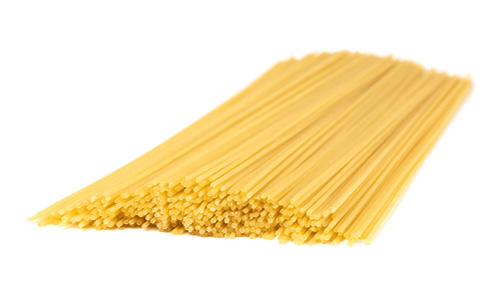
"Capelli d'angelo" is Italian for "angel hair,” thinnest of all pasta strands. Because it is so thin, it cooks in as few as 2 minutes! Angel Hair is great for light entrees, side dishes or soups. This delicate pasta works best with very thin tomato-based or broth-based sauces or simple olive oil tosses. Use finely chopped vegetables, seafood or chicken in angel hair tosses to match the delicacy of this shape.
Capellini
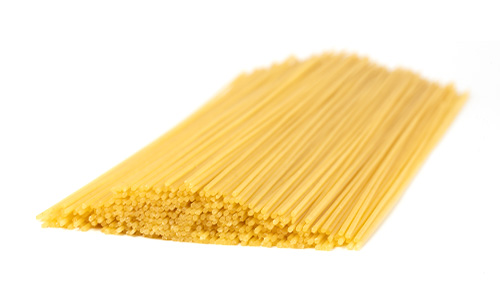
Capellini literally translates to “little hairs.” its long, cylindrical shape is similar to spaghetti but much thinner. Capellini cooks very quickly and has a delicate texture, making it perfect for light entrees, side dishes, or soups. It pairs well with seafood, light tomato sauces, and olive-oil-based sauces.
Vermicelli
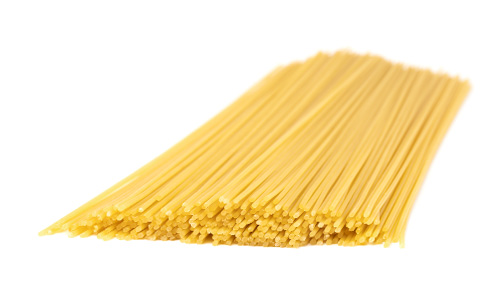
From the Latin "verme" for "worms", vermicelli is round thin pasta strands that are thinner than spaghetti. Vermicelli, as versatile as spaghetti, but not as hearty, is for those who prefer less "bite".
Spaghetti
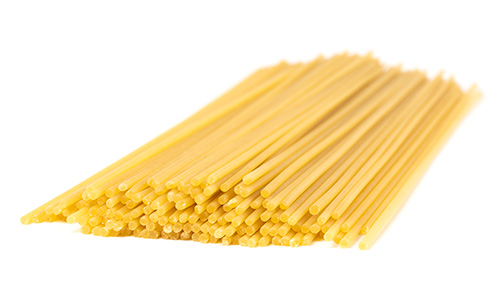
From the Italian word for "strings,” these thin round strands are our most beloved pasta shape. A versatile pasta shape, spaghetti can be used in entrées, side dishes, cold salads, or broken and used in soups. Toss spaghetti with almost any pasta sauce of varying thickness. Tomato or cream sauces, broth-based sauces, olive oil tosses and meat sauces all work well with spaghetti.
Linguine

Little tongues in Italian, this narrow, flat pasta is a specialty of southern Italy. Linguine is frequently paired with white or red clam sauce. Used in entrees or side dishes, linguine works well with almost any type of pasta sauce.
Fettuccine
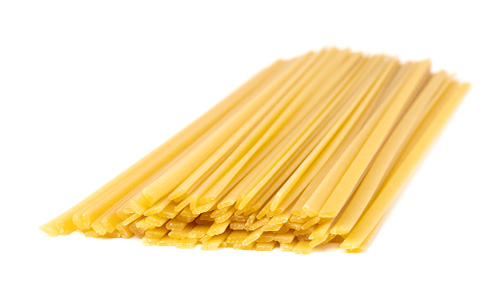
"Little ribbons" in Italian, this shape originated in Rome. These flat wide pasta strands are classically paired with Alfredo Sauce, a rich cream sauce with Parmesan cheese. This robust pasta is best in entrées and side dishes. Cream sauces, olive oil or butter pairs well with Fettuccine, but tomato sauces of medium to thick consistency can also be used.
Elbows
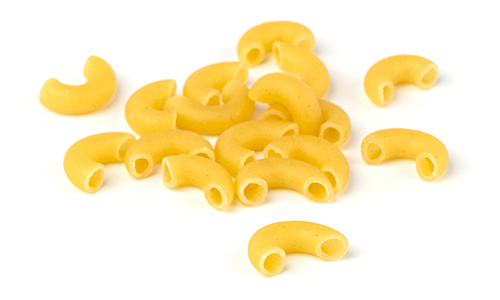
Elbow Macaroni is short curved tubular pasta in a semi-circle shape. Elbow Macaroni is versatile because of its short cooking time and familiar shape. Most commonly associated with "Macaroni & Cheese,” Elbow Macaroni can also be used with tomato-based or creamy sauces in entrées or in salads, soups, and baked dishes.
Cavatappi
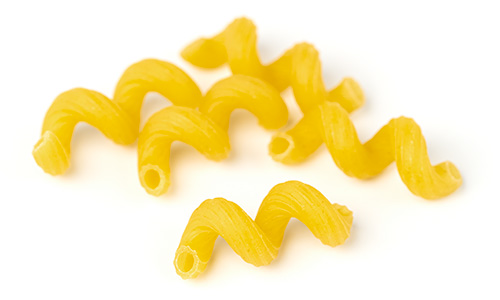
Cavatappi is a tubular corkscrew or spiral-shaped pasta about 1 inch long and native to southern Italy. Use Cavatappi in entrées and side dishes, baked dishes or cold salads. Just about any type of tomato-based or cream sauce complements the versatile shape of Cavatappi.
Farfalle
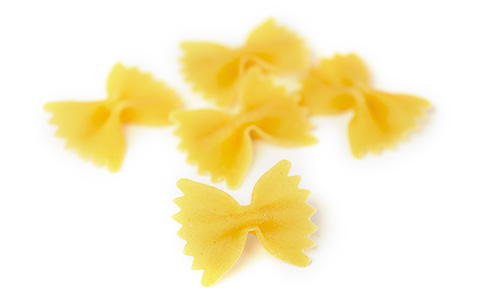
"Butterflies" in Italian; medium-sized pasta with a crimped center and pinked edges to form the shape of a bow tie. Farfalle is great in entrées, side dishes, cold salads or baked dishes. Almost any type of sauce complements Farfalle, but it's nice to showcase the fancy shape by using a lighter sauce.
Mostaccioli Rigati
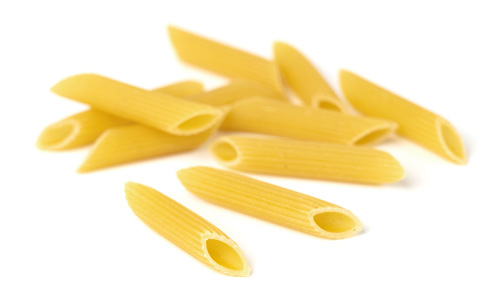
Italians describe mostaccioli as "little mustaches.” They are diagonally cut tubular shapes similar to penne, but larger. Mostaccioli Rigati has a ridged surface. Versatile in size and shape, Mostaccioli Rigati is good in entrées, side dishes, baked dishes and cold salads. Almost any favorite pasta sauce is complementary. Thinner sauces work better with Mostaccioli Rigati since the ridges "hold" the sauce. Thicker sauces will cling to smooth mostaccioli.
Penne Rigate
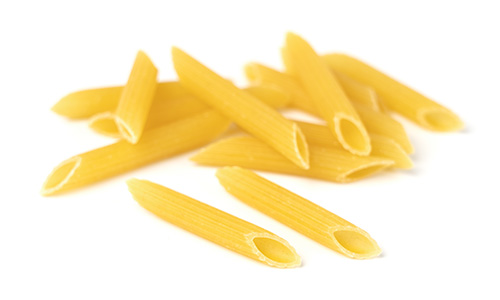
From the Latin for "feathers" (reminiscent of old-fashioned quill pens), Penne Rigate is a diagonally cut tubular shape with ridged surfaces. Versatile in size and shape. Use it in entrées, side dishes, soup, oven bakes or cold salads. Most pasta sauces are great with Penne Rigate, but thinner sauces will cling to ridges in penne.
Rotelle
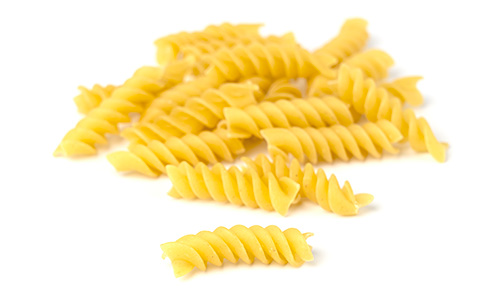
Rotelle is corkscrew or spiral-shaped pasta, about 1 ½ inches long. One of the most versatile of all pasta shapes, you can use Rotelle in entrées, oven bakes, side dishes, soups and cold salads. This pretty shape can be paired with almost any favorite pasta sauce.
Rotini
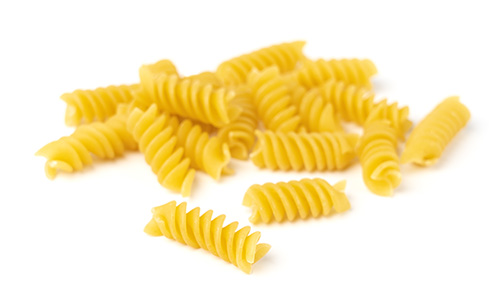
Rotini is corkscrew or spiral shaped pasta, about 1 ½ inches long. One of the most versatile of all pasta shapes, you can use Rotini in entrées, oven bakes, side dishes, soups and cold salads. This pretty shape can be paired with almost any favorite pasta sauce.
Shells
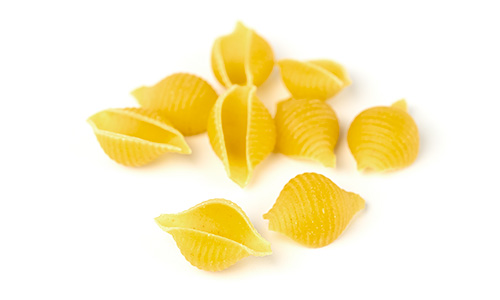
Called "conchiglie" in Italian, there are many sizes of these seashell-shaped pastas. Everyone loves Shells in entrées, oven bakes, side dishes, soups and cold salads. Any favorite medium to thick pasta sauce works with Shells.
Trio Italiano®
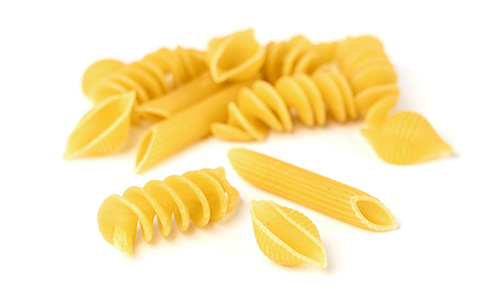
Trio Italiano® is a combination of three shapes in one box: Rotini, Penne, and Shells. With three cuts in one box, it is perfect for use in cold salads.
Acini Di Pepe
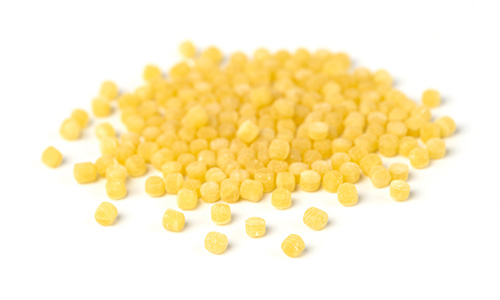
Italian for "peppercorns,” Acini Di Pepe look like tiny bead-shaped pasta. Acini Di Pepe works well in any soup or cold salads; try our famous classic "Frog's Eye Salad" that's fun for kids.
Ditalini
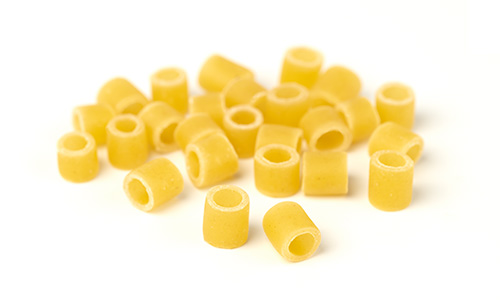
"Little thimbles" in Italian. A smaller cousin of elbow macaroni, ditalini is a straight smooth tubular shape. Ditalini is versatile and can be used in hearty soups, stews, salads and side dishes. Ditalini is often the shape used in Pasta Fagioli ("pasta and beans"), a classic thick Italian soup.
Orzo
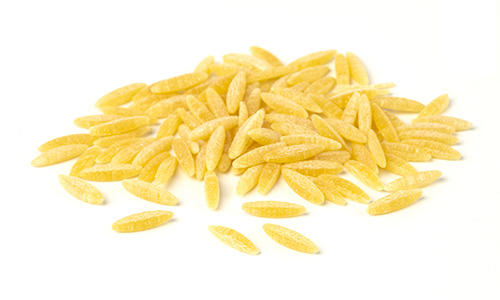
The Italian translation for orzo is "barley,” but it's actually a small rice-shaped pasta. A great rice substitute, Orzo works well in soups, stews, pilafs, side dishes and salads.
Pastina
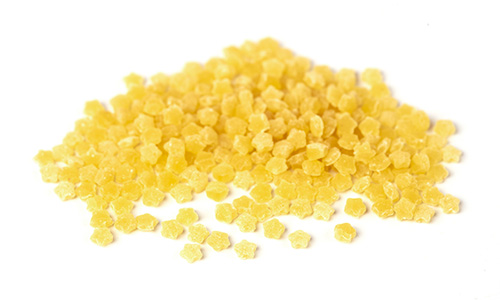
Italian for "tiny dough,” Pastina is the smallest shape we make; if you look closely, they're in the shape of a five-pointed star. Pastina works best in light soups. It is often made in single servings for one of a toddler's first foods.
Jumbo Shells
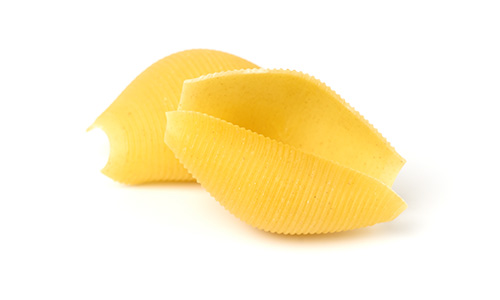
Called "conchiglie" in Italian, there are many sizes of these seashell-shaped pastas. Everyone loves Shells in entrées, oven bakes, side dishes, soups and cold salads. Any favorite medium to thick pasta sauce works with Shells.
Pot Pie
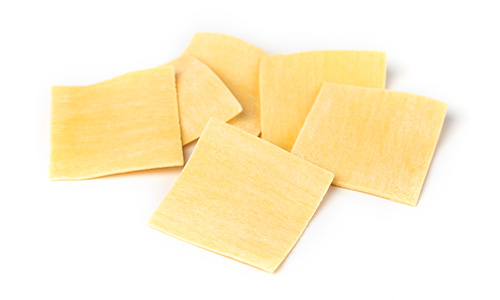
Pot Pie Bows and Squares are traditional egg-based pasta shapes just like Mom used to make from scratch.
Lasagna
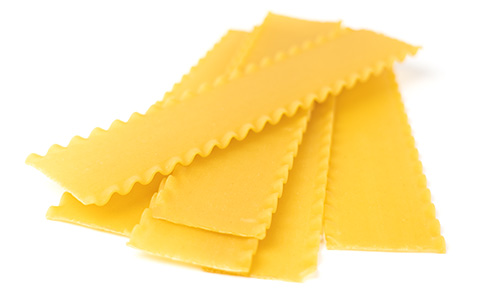
America's favorite baking shape. Some culinary authorities think the name comes from Latin, meaning "cooking pot". Lasagna are ripple-edged strips about 2 ¼ inches wide and 10-inches long. Almost exclusively used to make oven-baked entrées. Pasta is undercooked, then layered with tomato or cream sauces, cheese, meat (or seafood) or vegetables, then oven baked until pasta is done. Lasagna can also be cooked longer to make roll-ups; individual pieces are spread with cheese filling, rolled up, covered with sauce and oven baked.
Manicotti
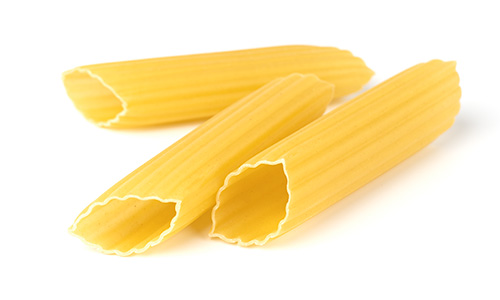
Derived from the Latin "manica" for "sleeve" or "little muffs,” these are large tubular-shaped pasta, typically stuffed and baked. Manicotti are undercooked, then stuffed with cheese, meat, or vegetable fillings, covered with sauce, then oven baked until the pasta is done. Manicotti is a great entree for entertaining since it can be prepared ahead of time, covered and refrigerated up to 24 hours before baking.
Mafalda
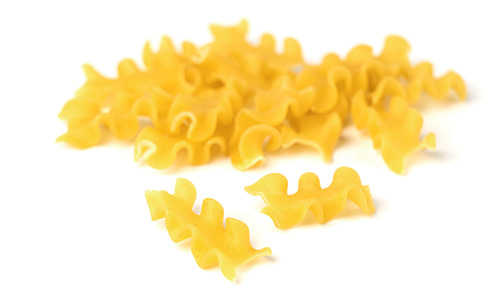
Derived from the Latin "manica" for "sleeve" or "little muffs,” these are large tubular-shaped pasta, typically stuffed and baked. Manicotti are undercooked, then stuffed with cheese, meat, or vegetable fillings, covered with sauce, then oven baked until the pasta is done. Manicotti is a great entree for entertaining since it can be prepared ahead of time, covered and refrigerated up to 24 hours before baking.
Rigatoni
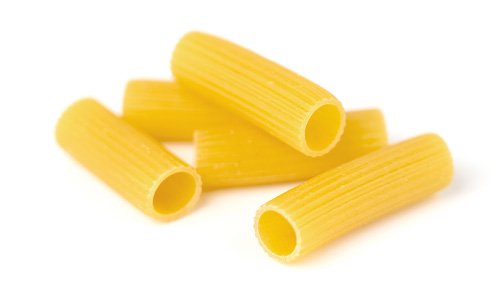
Rigatoni is large, ribbed tubes about 1 ½ inches long. This chunky pasta is frequently used in oven-baked dishes, but it can also be used in pasta "tosses" and salads. Hearty, rich sauces, either creamy or tomato-based, complement Rigatoni.
Ziti
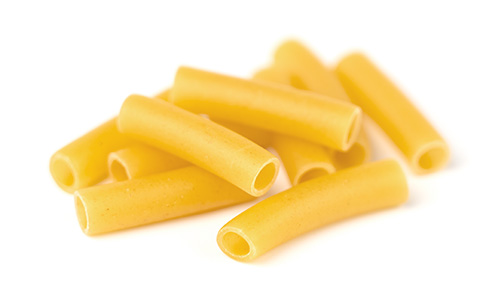
Ziti is medium-sized tubular pasta about 2 inches long and slightly curved. This classic Southern Italian pasta means "bridegrooms"; it is often served at Sicilian weddings. Ziti is traditionally served in oven-baked dishes with tomato sauce and mozzarella cheese. It works as well in any entrée, side dish or cold salad. Smooth Ziti can handle thicker sauces, while ridged Ziti Rigati "holds" thinner sauces better.
Angel Hair

"Capelli d'angelo" is Italian for "angel hair,” thinnest of all pasta strands. Because it is so thin, it cooks in as few as 2 minutes! Angel Hair is great for light entrees, side dishes or soups. This delicate pasta works best with very thin tomato-based or broth-based sauces or simple olive oil tosses. Use finely chopped vegetables, seafood or chicken in angel hair tosses to match the delicacy of this shape.
Capellini

Capellini literally translates to “little hairs.” its long, cylindrical shape is similar to spaghetti but much thinner. Capellini cooks very quickly and has a delicate texture, making it perfect for light entrees, side dishes, or soups. It pairs well with seafood, light tomato sauces, and olive-oil-based sauces.
Vermicelli

From the Latin "verme" for "worms", vermicelli is round thin pasta strands that are thinner than spaghetti. Vermicelli, as versatile as spaghetti, but not as hearty, is for those who prefer less "bite".
Spaghetti

From the Italian word for "strings,” these thin round strands are our most beloved pasta shape. A versatile pasta shape, spaghetti can be used in entrées, side dishes, cold salads, or broken and used in soups. Toss spaghetti with almost any pasta sauce of varying thickness. Tomato or cream sauces, broth-based sauces, olive oil tosses and meat sauces all work well with spaghetti.
Linguine

Little tongues in Italian, this narrow, flat pasta is a specialty of southern Italy. Linguine is frequently paired with white or red clam sauce. Used in entrees or side dishes, linguine works well with almost any type of pasta sauce.
Fettuccine

"Little ribbons" in Italian, this shape originated in Rome. These flat wide pasta strands are classically paired with Alfredo Sauce, a rich cream sauce with Parmesan cheese. This robust pasta is best in entrées and side dishes. Cream sauces, olive oil or butter pairs well with Fettuccine, but tomato sauces of medium to thick consistency can also be used.
Elbows

Elbow Macaroni is short curved tubular pasta in a semi-circle shape. Elbow Macaroni is versatile because of its short cooking time and familiar shape. Most commonly associated with "Macaroni & Cheese,” Elbow Macaroni can also be used with tomato-based or creamy sauces in entrées or in salads, soups, and baked dishes.
Cavatappi

Cavatappi is a tubular corkscrew or spiral-shaped pasta about 1 inch long and native to southern Italy. Use Cavatappi in entrées and side dishes, baked dishes or cold salads. Just about any type of tomato-based or cream sauce complements the versatile shape of Cavatappi.
Farfalle

"Butterflies" in Italian; medium-sized pasta with a crimped center and pinked edges to form the shape of a bow tie. Farfalle is great in entrées, side dishes, cold salads or baked dishes. Almost any type of sauce complements Farfalle, but it's nice to showcase the fancy shape by using a lighter sauce.
Mostaccioli Rigati

Italians describe mostaccioli as "little mustaches.” They are diagonally cut tubular shapes similar to penne, but larger. Mostaccioli Rigati has a ridged surface. Versatile in size and shape, Mostaccioli Rigati is good in entrées, side dishes, baked dishes and cold salads. Almost any favorite pasta sauce is complementary. Thinner sauces work better with Mostaccioli Rigati since the ridges "hold" the sauce. Thicker sauces will cling to smooth mostaccioli.
Penne Rigate

From the Latin for "feathers" (reminiscent of old-fashioned quill pens), Penne Rigate is a diagonally cut tubular shape with ridged surfaces. Versatile in size and shape. Use it in entrées, side dishes, soup, oven bakes or cold salads. Most pasta sauces are great with Penne Rigate, but thinner sauces will cling to ridges in penne.
Rotelle

Rotelle is corkscrew or spiral-shaped pasta, about 1 ½ inches long. One of the most versatile of all pasta shapes, you can use Rotelle in entrées, oven bakes, side dishes, soups and cold salads. This pretty shape can be paired with almost any favorite pasta sauce.
Rotini

Rotini is corkscrew or spiral shaped pasta, about 1 ½ inches long. One of the most versatile of all pasta shapes, you can use Rotini in entrées, oven bakes, side dishes, soups and cold salads. This pretty shape can be paired with almost any favorite pasta sauce.
Shells

Called "conchiglie" in Italian, there are many sizes of these seashell-shaped pastas. Everyone loves Shells in entrées, oven bakes, side dishes, soups and cold salads. Any favorite medium to thick pasta sauce works with Shells.
Trio Italiano®

Trio Italiano® is a combination of three shapes in one box: Rotini, Penne, and Shells. With three cuts in one box, it is perfect for use in cold salads.
Acini Di Pepe

Italian for "peppercorns,” Acini Di Pepe look like tiny bead-shaped pasta. Acini Di Pepe works well in any soup or cold salads; try our famous classic "Frog's Eye Salad" that's fun for kids.
Ditalini

"Little thimbles" in Italian. A smaller cousin of elbow macaroni, ditalini is a straight smooth tubular shape. Ditalini is versatile and can be used in hearty soups, stews, salads and side dishes. Ditalini is often the shape used in Pasta Fagioli ("pasta and beans"), a classic thick Italian soup.
Orzo

The Italian translation for orzo is "barley,” but it's actually a small rice-shaped pasta. A great rice substitute, Orzo works well in soups, stews, pilafs, side dishes and salads.
Pastina

Italian for "tiny dough,” Pastina is the smallest shape we make; if you look closely, they're in the shape of a five-pointed star. Pastina works best in light soups. It is often made in single servings for one of a toddler's first foods.
Jumbo Shells

Called "conchiglie" in Italian, there are many sizes of these seashell-shaped pastas. Everyone loves Shells in entrées, oven bakes, side dishes, soups and cold salads. Any favorite medium to thick pasta sauce works with Shells.
Pot Pie

Pot Pie Bows and Squares are traditional egg-based pasta shapes just like Mom used to make from scratch.
Lasagna

America's favorite baking shape. Some culinary authorities think the name comes from Latin, meaning "cooking pot". Lasagna are ripple-edged strips about 2 ¼ inches wide and 10-inches long. Almost exclusively used to make oven-baked entrées. Pasta is undercooked, then layered with tomato or cream sauces, cheese, meat (or seafood) or vegetables, then oven baked until pasta is done. Lasagna can also be cooked longer to make roll-ups; individual pieces are spread with cheese filling, rolled up, covered with sauce and oven baked.
Manicotti

Derived from the Latin "manica" for "sleeve" or "little muffs,” these are large tubular-shaped pasta, typically stuffed and baked. Manicotti are undercooked, then stuffed with cheese, meat, or vegetable fillings, covered with sauce, then oven baked until the pasta is done. Manicotti is a great entree for entertaining since it can be prepared ahead of time, covered and refrigerated up to 24 hours before baking.
Mafalda

Derived from the Latin "manica" for "sleeve" or "little muffs,” these are large tubular-shaped pasta, typically stuffed and baked. Manicotti are undercooked, then stuffed with cheese, meat, or vegetable fillings, covered with sauce, then oven baked until the pasta is done. Manicotti is a great entree for entertaining since it can be prepared ahead of time, covered and refrigerated up to 24 hours before baking.
Rigatoni

Rigatoni is large, ribbed tubes about 1 ½ inches long. This chunky pasta is frequently used in oven-baked dishes, but it can also be used in pasta "tosses" and salads. Hearty, rich sauces, either creamy or tomato-based, complement Rigatoni.
Ziti

Ziti is medium-sized tubular pasta about 2 inches long and slightly curved. This classic Southern Italian pasta means "bridegrooms"; it is often served at Sicilian weddings. Ziti is traditionally served in oven-baked dishes with tomato sauce and mozzarella cheese. It works as well in any entrée, side dish or cold salad. Smooth Ziti can handle thicker sauces, while ridged Ziti Rigati "holds" thinner sauces better.
acini di pepe • angel hair • capellini • cavatappi • ditalini • elbows • farfalle • fettuccine • lasagna • linguine • mafalda • manicotti • mostaccioli rigati • orzo • oven ready lasagna • pastina • penne rigate • pot pie bows • pot pie squares • rigatoni • rotelle • rotini • shells • spaghetti • trio italiano® • vermicelli • ziti • ziti rigati


